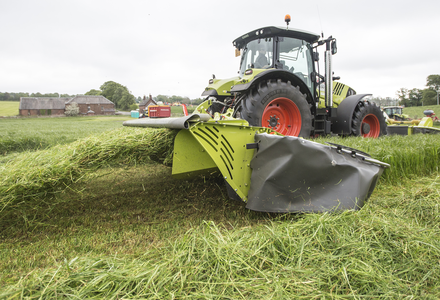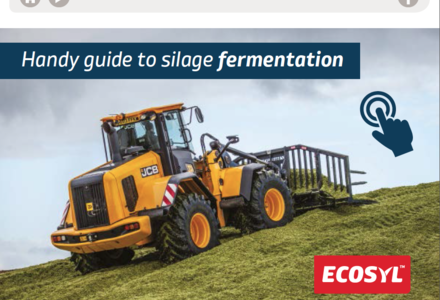Fermentation - the secrets under the covers
02 March 2021
Achieving a good fermentation is key to making the best grass silage. But what actually goes on in your clamp?
 Are you one of those farmers who sets everything up ‘just so’ in the clamp, leaving nothing to chance? Or do you load grass in, roll it, sheet it and hope for the best?
Are you one of those farmers who sets everything up ‘just so’ in the clamp, leaving nothing to chance? Or do you load grass in, roll it, sheet it and hope for the best?
Either way, some sort of fermentation is going to happen, says Volac product manager Jackie Bradley.
The issue is that some fermentation types could lose much more of the silage’s tonnes of dry matter and nutrient value than others, she adds.
Mrs Bradley says: “Our Cut to Clamp initiative, which was launched two years ago to help farmers, provides a blueprint for each of six key stages of silage-making and utilisation. These are: cutting, wilting, harvesting, treating, clamping and feeding.
“Several stages have an impact on fermentation. By understanding what an ideal fermentation looks like, it is easier to appreciate why certain steps are so important to get right.”
Ideal fermentation
Fundamentally, Mrs Bradley says fermentation is a natural process, whereby the crop’s own sugars – glucose or fructose – are converted to acid, which ‘pickles’ the forage to preserve it. However, in some types of fermentation, other less desirable by-products are also produced.
“In an ideal fermentation, sugar is converted only to lactic acid,” she says.
“This is ideal because lactic acid is a beneficially strong acid. This means it produces a rapid ‘pickling’ effect, through a rapid pH fall. So the growth of undesirable micro-organisms, which would otherwise ‘feed’ on silage, is quickly stopped.”
However, there is another advantage in this type of fermentation, she adds.
“Because only lactic acid is produced, with no undesirable by-products, there is very little loss of energy during this conversion process. It is only about 0.7% less than in the original sugar.
This type of fermentation is termed ‘homo-fermentative’ because there is only one end product: lactic acid.
“This type of fermentation is favoured when a proven silage additive delivering high numbers of efficient lactic acid-producing bacteria is used,” she says.
Poor fermentation
In contrast to this, Mrs Bradley says a poor fermentation occurs when less efficient lactic acid-producing bacteria, or other even less desirable bacteria, such as enterobacteria contained in slurry, are present and allowed to convert sugars in grass.
She says: “The problem with these bacteria is they produce a mixture of different end products, besides lactic acid. These can include acetic acid, which is vinegar, and ethanol.
This type of fermentation is termed ‘hetero-fermentative’. It is less desirable because acetic acid is a relatively weak acid, which means the pickling process is slower, so any undesirable microbes present can feed on silage for longer, using up more of its nutrients.
“In addition, ethanol is not an acid at all, so it does not help.
“To make matters worse, carbon dioxide is also produced in this process. Since carbon dioxide comes from the breakdown of sugar in grass, it wastes the energy contained in the original sugar and depletes dry matter.”
A particularly poor fermentation occurs when clostridia bacteria are introduced from soil. These convert good lactic acid into less desirable butyric acid, wasting about 18% of the original energy in the process, as well as resulting in unpalatable silage, she adds.
Natural vs. treated
Because fresh grass naturally contains a mixture of good and bad bacteria, if it is left to ferment naturally, it is possible for all these types of fermentation to happen, Mrs Bradley explains.
She says: “Although some beneficial bacteria will be present, they may be in low numbers and not necessarily the most efficient types.
“Avoiding slurry and soil contamination of grass will reduce the undesirable bacteria. Also, maximising the sugar available in grass – for example by cutting at the optimum growth stage and achieving a rapid wilt – will help fermentation quality.
“Similarly, wilting to the correct dry matter and exclusion of air from the clamp, by combining the optimum chop length with good consolidation and effective sealing, will also help.
“This is because an efficient fermentation only starts once air in the clamp has been used up.”
However, an integral part of Cut to Clamp is the use of a proven additive. This can introduce as many as a million beneficial bacteria per gram of forage treated when used correctly to dominate the fermentation in favour of maximising lactic acid production.
“Research clearly shows how much quicker the pH falls when a proven additive is used, and how much more of the silage’s dry matter is retained [see graphs 1 and 2].
“A good fermentation should result in a high ratio of lactic acid to other acids,” she adds.
Preserving protein
As soon as grass is cut, its protein starts to be broken down, explains Mrs Bradley, initially by enzymes in the plant itself, but then also by undesirable micro-organisms present.
This results is a loss of true protein, she adds.
“As well as helping in other ways, a rapid fermentation to a stable pH will also quickly inhibit the plant enzymes and microorganisms that cause protein breakdown [see graph 3].
“Another problem after cutting is that sugars are used up in the grass by the plant continuing to respire and by the respiration of micro-organisms.
Rapid wilting, together with effective consolidation and sheeting to remove and seal out air, and a proven additive, will also reduce these respiration losses.
Ultimately, producing and feeding better silage will benefit the cow. Compelling results from 15 trials on a range of forages showed that feeding silage treated with Lactobacillus plantarum MTD/1, which is the beneficial bacterial strain in Ecosyl, gave an average milk yield increase of 1.2 litres/cow/day.
Follow the silage
How serious are you about making more milk from forage? Serious enough to re-assess the whole way you make, store and feed your silage?
You don't have to do it alone. With a FREE Cut to Clamp silage audit we can help and what's more we have now launched our new Follow the Silage series!
Over the course of a year we’ve captured a video diary of the whole audit process on a real-life Cheshire dairy farm:
- How a Cut to Clamp audit actually works
- The changes recommended and implemented as a result of it
- The benefits that are starting to be seen






